Cruising in the Bering Sea
Incoming Professor of Marine Science, Dr. Steven Baer, is cruising in the Bering Sea this summer with the Arctic Shelf Growth, Advection, Respiration and Deposition Rate Measurements (ASGARD) project. You can follow Dr. Baer’s adventures and learn more about the mission of his cruise in the blog below. You can check out additional pictures of the cruise on the Instagram pages of the North Pacific Arctic Board Research Program (which is funding the cruise) and the R/V Sikuliaq.
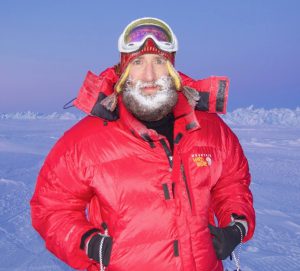 About Dr. Steven Baer
About Dr. Steven Baer
Dr. Baer is a marine biogeochemist whose research interests are focused on the interface between microbiology and the chemical environment, and how phytoplankton diversity impacts competition for nutrients. Dr. Baer’s role in the ASGARD expedition is to measure phytoplankton diversity and growth rates. The Arctic is warming much more rapidly than the rest of the Earth, and this has strong implications for Arctic ecosystems and fisheries there. Dr. Baer’s work will help elucidate how changes in the Bering Sea will potentially impact fish catches.
7/7/18
Further thoughts
As a researcher, I follow the news on environmental issues. Pollution, climate change, food production, etc. I try to make personal choices that reflect my principles and minimize my impact on our pale blue dot (i.e. Earth). But something that is hard to avoid is travel. Driving, flying, working on a ship… these all use a lot of fuel, but all are necessary to perform the research I need to do. My friend Andrew McDonnell (Assistant Professor of Oceanography at University of Alaska) is working on particle export during this cruise. That’s basically how particles (living and dead phytoplankton and bacteria along with fecal pellets and other aggregates) make it from the surface down through the water column. Andrew is also a deep thinker on issues of climate change. He wrote a really thought-provoking piece on the bigger picture of working at sea in light of his research interests. I encourage you to take a look: https://blog.arctic.nprb.org/blog/2018/6/25/an-insidious-irony
7/6/18
Science wrap
My research has taken me to the Arctic many times over the past 10 years. It is an area that is changing rapidly, due to rapidly thinning and receding sea ice. You can see the data at the US National Snow and Ice Data Center. I’ve looked at those plots and read the literature on Arctic ecosystem changes. But it’s not until I visited the region that I had a real visceral sense of receding sea ice. Twenty years ago, people trying to sail through the Bering Strait in early June would have been blocked by sea ice. Now, we can travel all the way up to 70°North without so much of a hint of ice.
That’s the point of this project: how is the ecosystem changing with the climate-driven shifts in timing and volume of sea ice in the Bering and Chukchi Seas? I’m measuring the base of the food web: phytoplankton diversity and primary production. Currently, the system is dominated by sea-ice algae communities that grow in a big Spring pulse. That feeds the microscopic predators (and the food chain), but there is so much algal growth and the Bering Sea is so shallow that much of the decaying material makes it to the seafloor, feeding a rich sedimentary layer. This large pulse of food sets the timing for everything from zooplankton predators to whales and bird and walrus feeding and migrations. Based on prior observational and theoretical work, we expect this to change to a more productive but also more dilute system where the algae are spread out over the water column and over a longer time period.
To understand the changes to the ecosystem, we have traveled throughout the region, stopping for CTD casts, sediment grabs and cores, and both mid-water and benthic trawls. Marine mammal and bird observers keep an eye out the whole time for sighting and identifying large animals. When the opportunity presented itself, an Acrobat instrument was towed behind the ship to get real-time measurements of physical and chemical properties, along with chlorophyll. We conducted 101 CTD casts over the course of the cruise at 49 stations. At each of these, data was collected on the nutrient chemistry of the water column, the identity (visual and genomic) and activity of everything from algae to benthic worms and clams, zooplankton, fishes, and birds and mammals. Experiments were performed and samples were taken to see how the food web connects among the different organisms, and how they may change in future scenarios.
To create this snapshot of the food web, there was a team of over 20 scientists, supported by a similar number of ship’s crew, all working together for about a month at sea. It’s a lot of work, which goes on seven days a week, with many people putting in 18+ hour days. That’s just for this cruise. Repeat cruises at different times of the year will help us understand how the Arctic is changing over a longer seasonal cycle. For me, the work has just begun. Many of the samples we collected get taken back to the lab to analyze, which can take months. Then there’s actually understanding the data and writing it up for publication. In all, it’s been a great journey, and one that I’m excited to continue.
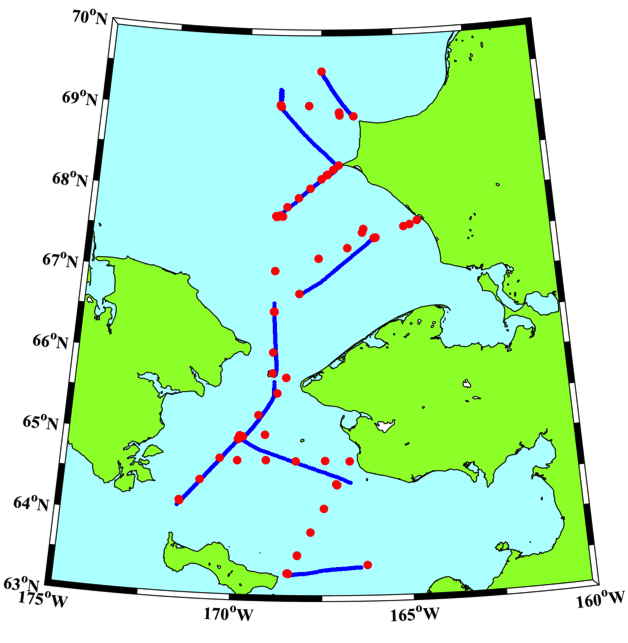
Location of CTD sampling stations (red) and Acrobat transects (blue) on cruise SKQ201813S. Map created by S. Danielson (UAF).
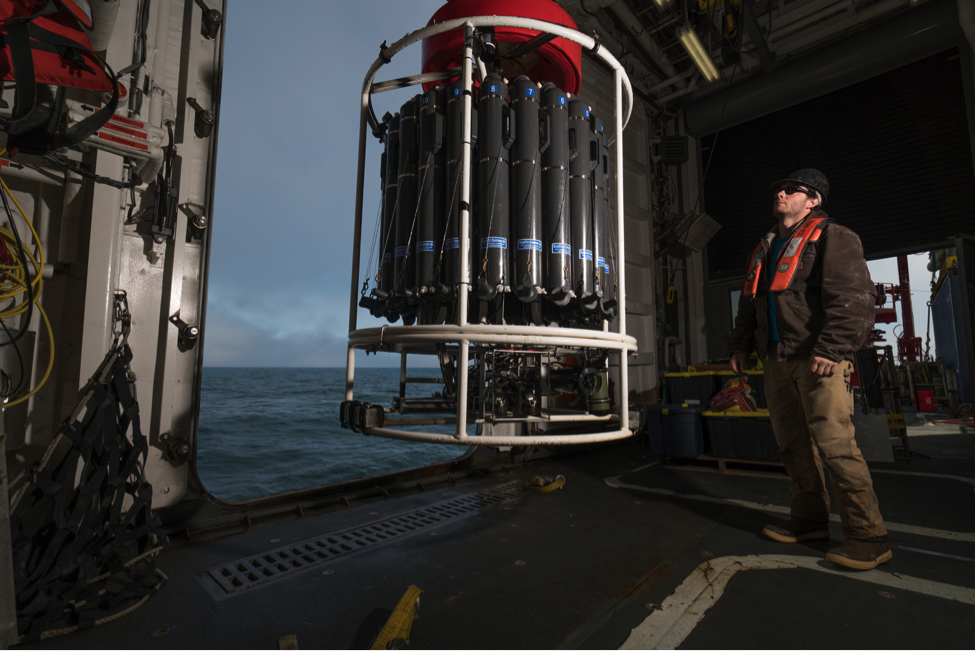
Ethan Roth, RV Sikuliaq’s marine technician, overseeing the CTD deployment. Picture by A. McDonnell (UAF).
7/4/18
Being away
There are a lot of benefits of being away. The ability to be really present and focused on the job in front of me, meaning there are no distractions to getting science done, is a rare treat in the world of science. Usually, there are so many different things to get done just at work: multiple projects, writing, lab work, etc. And then at home, I have to take care of myself. Out here, somebody else is doing all the cooking and cleaning. Very limited internet connectivity, and certainly no phones or texting, means I can’t handle bills or deal with problems or really be responsible for anything that needs doing at home. My time aboard is pretty limited – only four weeks – which has given me a taste of what life at sea is like. In some ways, research cruises are like summer camp for grownups: you’re fully immersed in your job and life and making new connections; you’re eating communally and living in tight quarters. Many of the crew members are at sea for eight or more months per year, working demanding, long days during much of it. Most I talk to enjoy the life and become fully immersed in the satisfactions of their life and work aboard the vessel. And because time at home can be limited, it makes you fully appreciate the life you have and live fully in the time at home.
Being away from home can also be terribly hard. I generally find that after about three weeks, I tire of the limited living space and sampling can become monotonous. Days take on a pattern of up early, maybe exercise, prepare for science, eat, CTD, filtering and setting up experiments, eat, take a short break, break down experiments, eat, clean up the lab, prepare for the following day, eat some more, read a little, and get to sleep. They are long days with lots of activity. Staying busy and on top of the work is important. But I miss my family and being home. I am both amazed that we have connectivity at all and annoyed it’s not better. With all the work and the distance from home, I can lose track of days. I miss birthdays and other
important events. I get snippets of news from home, but not enough to truly process. At the same time, I don’t miss political news. At all. Recently, my community at home was hit hard by the death of a local teenager. I couldn’t be there for my family and friends, which is hard in both directions. I had a hard time connecting emotionally to the news, and it’s created some distance with people at home. It’s all a wash amidst sampling, and eating, and sampling. I am prepared to be fully present when I get home and hope that I can do a lot of catching up.
In a strange way, being at sea allows for the mental (and physical) space to think hard about some things that I simply didn’t have the space to consider when I was home. During the first half of 2018, I was fairly consumed by my father’s diagnosis with pancreatic cancer, and his treatment, and subsequent passing. With my own family to take care of, support for my sister and mom, a new job at MMA, along with my current job at Bigelow, it was hard to reconcile all the jumble of emotions I was feeling. Being at sea, especially with a few days of transit (i.e. limited science responsibilities) at the beginning, allowed me to spend some time just staring at the horizon, finding quiet space to be alone with my thoughts. I believe it was Ibsen who said something like “the cure for everything is salt water: sweat, tears, and the sea.” I am grateful to have all three right now.
6/18/18
Safety
There are not a lot of environments where everyone I see has knife attached to their belt. A knife comes in handy a surprising number of times every day. Cutting rope, prying something apart, chipping ice from the -80 freezer. I also carry a flashlight, both for use looking inside the instruments I’m using, but also in case of emergency. It was a recommendation of a captain on a ship I was on a few years ago.
[Editor’s note: Mom, if you are reading this, stop here.]
A bad day on a ship is very bad indeed. There is a lot of heavy equipment under tension, a moving platform, sleep deprivation, and great distance from help. On a previous trip to the Arctic, on a smaller and older vessel, there was a minor engine fire. It was contained quickly. The fire was not the real problem. The problem was that the fire prompted everyone on board to tell their at-sea horror stories. Real engine fires that made the deck so hot it melted sneakers; abandoning ship in a survival suit in under two minutes from the alarm; losing a finger to a door; and others. As the mate told us (with some hyperbole), “everything on this ship is carefully engineered to maim or kill you.”
Needless to say, safety is taken very seriously. One of the first things to happen after we leave shore is a safety briefing. It’s basically an orientation on how to behave on the ship, and what to do in case of an emergency. Where to muster, where the life rafts are, what to do in case of a fire. How to put on a survival suit. The Sikuliaq is outfitted with a newer model than the “Gumby” suits I’m familiar with. The new ones work more like a dry suit and take a little getting used to putting on… so we all do.
If we do have to abandon ship, I’ve come prepared with a “ditch bag”. It’s a small Ziploc that has a spare set of glasses, some sunscreen, a hat, and Advil. Something I can grab quickly if I need to, and stuff inside my survival suit. I was very proud of myself for having this at all, but the safety officer put my ditch bag to shame. He had an entire backpack with a spare knife, flares, batteries, Firestarter, granola bars, spare long underwear, all in water tight containers. I’m going to need to up my game.
The risk of an incident is low. I have supreme confidence in the ship and the safety consciousness of the crew. A U.S. government vessel follows a lot of protocols. Nonetheless, it’s comforting to take steps to maximize survival in the case of a really bad day.
6/17/18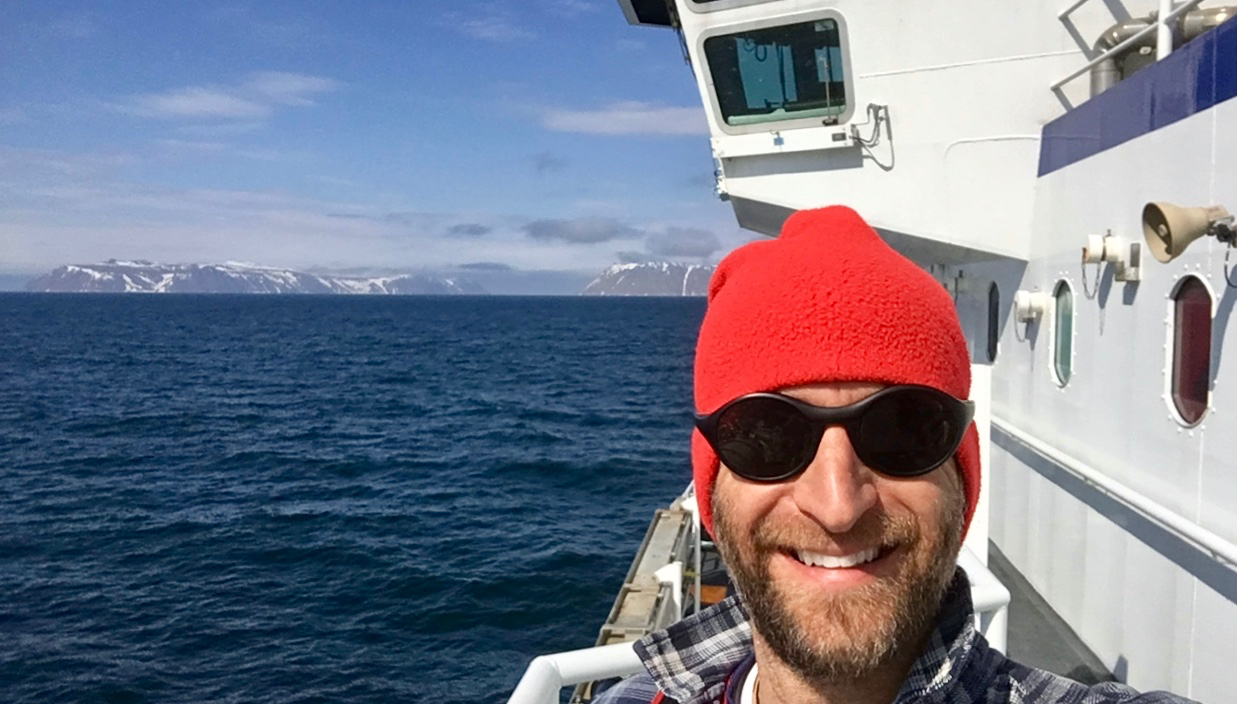
Borders
Any time we get close to land, I am stunned by the geography. Islands just rise up directly out of the ocean. It can feel very isolated out on the ship, but looking at the rugged coastline of northwest Alaska reminds me how far from modern society we really are.
The Bering Strait is the narrowest point of the Arctic Ocean, separating the Bering and Chukchi Seas. It’s also the narrowest point between North America and Asia, spanning only about 50 miles across. Right in the middle are two islands: Big and Little Diomede. Today we stopped at Little Diomede island to help remove some electronics waste. A native community of about 100 people live there. They are reliant on mostly subsistence hunting of marine species: walrus, seal, crabs. As such, they are integrally tied to the seasons and sensitive to climate, as the animals they rely on change distribution with the new ice conditions. But the community also relies on helicopters and modern energy production to continue to live there.
The Russian island, Big Diomede, is less than a mile away, but the native community was moved out to make way for a Russian military base during the Cold War. In a strange quirk, it is across the international date line, so despite its proximity, the two islands are a day apart on clocks. Despite the arbitrary nature of lines on a map, it feels remarkable to be between two worlds.
Iñuit communities across the polar environment are struggling to come to terms with modern culture while maintaining their native traditions. Whaling communities in Barrow, Alaska use explosive charges on their harpoons and front loaders to haul whales up on to the ice for harvest, but still hunt in sealskin boats and use traditional tools to carve the whale and distribute to the entire village. Visiting here on a large, ultra-modern ship filled with cutting edge scientific equipment, I am left wondering about our role here. We are involved in this expedition to quantify the impacts of changes in sea ice on the ecosystem. There is a community observer on board, helping us to put our measurements in the context of real people, who have been here for thousands of years. Are we helping? Are we making a difference? Are we learning anything new? I believe that we are. I believe that we are making novel discoveries. We are on the cutting edge of knowledge of how the marine system functions. We are trying to funnel that information to decision-makers, both in government and native communities. I hope that we too are straddling the worlds of modernity and tradition, science and belief.
6/15/18
Milkshakes
In passing, someone mentioned the desire for a milkshake. I was immediately interested in the idea of making a great milkshake. An obsession was born. But there are no tubs of ice cream on the ship.
So, much like everything else when on a ship, you have to solve your problems creatively. Even if that problem is wanting a milkshake, which isn’t really a problem.
My first attempt was to extract the ice cream from the middle of ice cream sandwiches. This involved the arduous task of eating the cookie part off and putting the ice cream into a blender with some frozen
strawberries. Not so good. It was about at this point that everyone on board started avoiding me. The next idea was to freeze some vanilla yogurt… again with frozen strawberries. Better. So the frozen
vanilla yogurt base is tasty. But I needed more/better flavor, so I decided to replace the strawberries with a frozen banana and chocolate syrup. The only problem being there was no chocolate syrup! But I persevered. I made a concentrated chocolate slurry from hot cocoa mix and added that. Delicious.
In the meantime, I was talking to one of the cooks about my milkshake obsession, looking for ideas. He wanted no part of it. But it did prompt him to get excited about how to use the ingredients on hand to
make a rich ice cream style dessert. His idea was at least two orders of magnitude greater than mine: cream cheese ice cream on top of a pine nut shortbread cookie, drizzled with a balsamic reduction. I love that man. But now I am on the hook to intern in the galley to help him make it.
This elusive hunt for a tasty milkshake is also a lot like science. Be curious about what can be done; where is the edge of our knowledge and comfort? Isolate your variables. Try something and change one thing at a time to see and document the impacts of incremental changes. Test it, try it. Fail. Keep trying. Endure ridicule. Fail some more. Persevere. Inspire others. Change what is thought possible. Make the world a little bit better. Drink a milkshake.
6/14/18
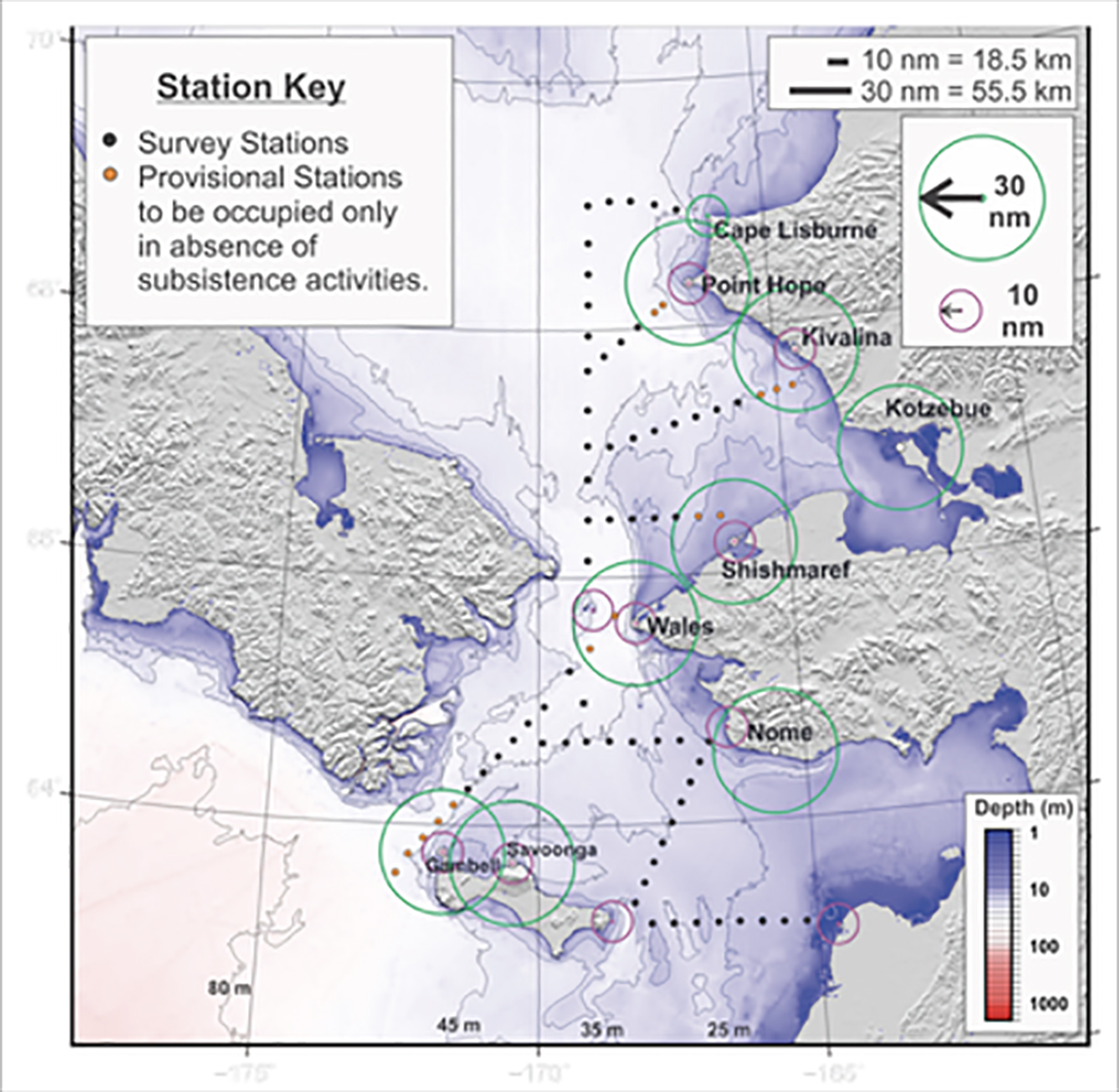
ASGARD station map
Why am I here?
I am a marine biogeochemist, focused on the interface between microbiology and the chemical environment. I am interested in how the diversity of phytoplankton impacts competition for nutrients. This has far-reaching implications for carbon cycling (i.e. climate change) and higher trophic level productivity (i.e. fisheries). My role during this expedition is to make measurements of phytoplankton
diversity and their growth rates. I use flow cytometry to quantify the species and biomass of everything from the smallest cyanobacteria (approximately 1 μm in diameter) to large chain-forming diatoms (which
can exceed 300 μm in length). In addition, I am using stable-isotope incubations of carbon and nitrogen to assess phytoplankton growth rates.
Phytoplankton, or microscopic algae, form the base of the marine food web. By studying which types of phytoplankton are living in the water column, I can start to understand how much carbon is available to go up the food web or to sink to the bottom, where they either feed the creatures inhabiting the sediments, or get buried, sequestering the carbon. Different types and sizes have different impacts. For example, small algae like cyanobacteria are not usually grazed very well, and it takes many steps on the food chain to get up to fish, losing energy through the extra steps in the process. Large organisms, such as diatoms, both tend to be a richer food source (i.e. more nutritious and less steps in the food chain), but also, because they are bigger, tend to sink out of the water column faster, making it to the bottom.
Just like plants on land, phytoplankton use energy from the sun to extract essential nutrients from their environment. The major macronutrients are carbon, nitrogen, and phosphorus, ust like fertilizer for a garden, giving the algae what they need to grow. I use special forms of these basic elements as a chemical tracer of their activity. I get water from a representative sampling of depths and put them into small, clear incubation bottles. Then I add small amounts of carbon and nitrogen compounds that are made with stable isotopes (13C and 15N). These isotopes are not radioactive – thus the term “stable” – and are just like “regular” elements, except with an extra neutron. The plankton don’t complain about any difference in taste. Next I put those bottles into a tank with flowing seawater, to mimic their temperature and light conditions. After six hours, I retrieve the bottle and filter them sequentially onto a few sizes of filters. During their six-hour incubation, they have been busy growing, using some of the stable isotopically labelled compounds I gave them. I can use a mass spectrometer to detect how much of that chemical tracer they took up, and then calculate how fast they are growing. By using different size filters, I can get some idea of how different members of the community are growing at different rates and therefore know how much carbon they are removing from the seawater.
Other participants in the research cruise will be measuring everything from physical parameters to nutrients, to zooplankton grazing, to fish species and gut contents, all the way up the trophic chain to seabirds and mammals. We are attempting to put all of the ecosystem pieces together. By measuring all the elements of the food web, we hope to gain an idea of how the diversity and rate measurements I am making fit into the larger whole. Who gets eaten? Who sinks to the bottom? How much carbon gets transferred to different parts of the water column and sediments? Does it make a difference on which types of organisms are there? What are the environmental conditions that favor one type of organism over another? These are some of the driving questions of my research, and the ASGARD project overall.
The current project has added urgency because of the rapid changes taking place in this region. The Arctic as a whole is warming much more rapidly than the rest of the Earth. This has led to widespread changes in sea ice cover, which has a cascading effect on the entire ecosystem. The Bering Sea is one of the most productive and valuable U.S. fisheries, dominated by the catch of pollock and crab. Current and future physical changes to the region are expected to have significant impacts on the biology that live there, but the specifics are fairly unknown. The current project, Arctic Shelf Growth, Advection, Respiration and Deposition Rate Measurements (ASGARD) is the second annual expedition to understand the changing physical environment and its impact on biological rates (growth, grazing, etc.). The results of this work will directly improve Arctic management and policy decisions in the coming decades.
6/13/18

FlowCam images
Wonder
One of the great things about my job is going to sea. It’s always an adventure; one that has allowed me to truly travel the world. In the past five years alone, I’ve been to Alaska (in the winter no less) many times, Antarctica, Hawaii, Thailand, and Australia. And those are just the ports. I’ve experienced raging storms in the North Atlantic and also the doldrums of the equatorial Indian Ocean. When you’re far from land, the view across the ocean stretches to the horizon in every direction. It’s an incredible sight but can get
boring to only see two shades of blue: the dark blue of the sea and the light blue of the sky. It’s why every sunrise and sunset tend to be events. If the weather is right, people tend to venture out on deck to spend a few minutes marking the day and quietly observing the ritual of sunset. To see the edge of the world and know that there are things beyond it.
People tend to view the sea from the surface, waiting for things to poke their heads out. The ocean is vast and deep, and retains a sense of wonder for me, and for my fellow scientists. When something charismatic (read: whales) appear, everyone stops what they are doing and rushes to the rail to get a view. On my current cruise in the Bering Sea, scientists are studying everything from what lives in the sediments to the birds that make a living flying above the ocean. While we are all focused on our individual projects, there is a lot of interest in seeing what everyone is up to: the crabs and sea stars that are pulled up in the trawl, the fish that show up in the nets, the fascinating worms that live in the seafloor, or even a dense mass of barnacle that made a mooring their home for the past year.
I study the microbial world. The plankton. Microscopic algae that are the base of the food web and a major driver of carbon flows in the ocean, and on Earth. I’m using an instrument called a FlowCam, which
is able to take pictures of these amazing autotrophs. We have it tuned to look at phytoplankton in the range of 5 – 200 microns (for scale, the width of a human hair is about 100 microns). Much like glimpsing creatures below the sea surface, I look at creatures that inhabit every drop of seawater but we never see. And just like the charismatic megafauna that we all gawk over, the images on the FlowCam cause a stir, and scientists and crew all come over to take a look at what’s in the water and talk about how the different organisms impact the entire ecosystem.
Despite our decades of cumulative experience, it is still amazing to catch a glimpse of what lives outside of our normal vision, both below the sea, and in every part of it, and beyond the horizon. And to experience and know that little bit more of our world.
6/6/18
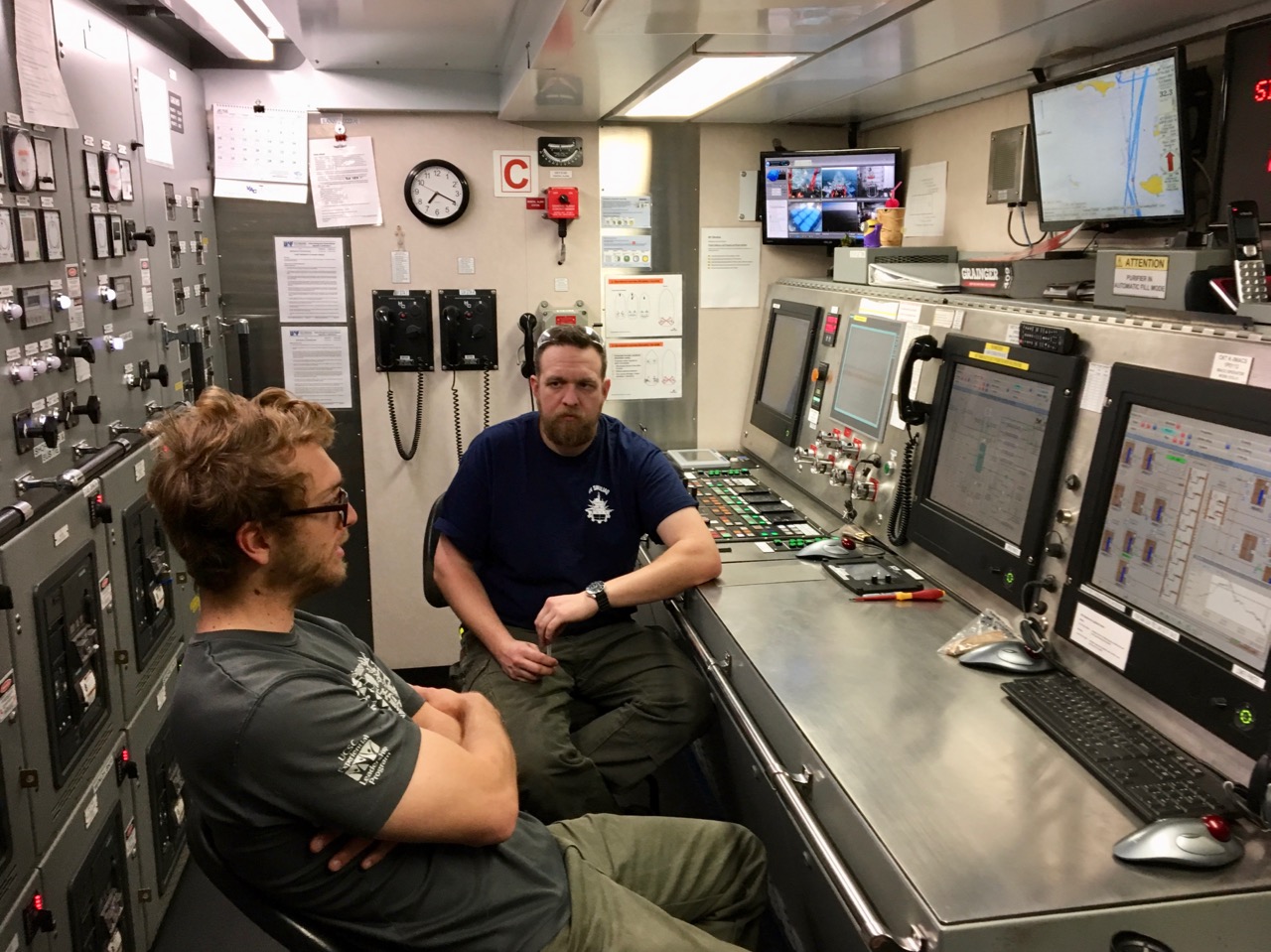
Eric the electrician and Kevin the second engineer (left to right)

Chemistry supply
Advice from a maritime grad
I had a conversation with the second assistant engineer, Kevin. He is a graduate of Cal Maritime Academy. He told me all about the ship’s operations, his career path, and advice for students still working toward their degree in marine engineering and/or science. He gave me a “behind the scenes” tour of the first and second platforms (the two levels below the main deck), where all of the ships engineering systems are located. Kevin’s knowledge of both the theory and practical application of all the systems is truly mind-blowing. The engines, mechanical and electrical systems, sewage treatment, heating and cooling systems, plus many more I’m likely forgetting, are all automated and generally controlled via touch-screen interfaces. Kevin has deep knowledge about how the computer systems are operating to control all these processes, but also the ability to find the physical part indicated on the screen to go maintain or fix it or modify it to do what he wants it to do.
Kevin’s first piece of advice for maritime students is to pay attention to the simulators in automation class. Even if you’re not an electrician almost everything that is done is run through computer software. Reporting on and controlling fuel levels, valves, emergency indicators, winches, etc., they are all run from a central automation hub. Especially for recent grads, you will likely be a nascent expert in automation. You may not have as much knowledge as the veterans, but pay attention, ask questions, and offer your knowledge.
Second – and with only a little prodding from me – Kevin said that “running a ship without chemistry is like flying a plane without aerodynamics.” His knowledge of chemistry is brought to bear every
day. Just as an example, there are additives to keep the fuel lines at the proper pH and prevent corrosion. Water is chemically treated both for sewage and for the distillation processes (thanks potable water). Incoming seawater used for cooling is chemically tested and treated, as biological contaminants, oxygen loading, and heat transfer are just a few issues the engineers are trying to manage.
Kevin’s interest in the maritime industry started in elementary school in southern California. He got involved in a high school program building solar-powered boats, which led him to marine engineering,
with a minor in marine science, at Cal Maritime Academy. After working on a variety of vessels (tugs, cruise ships, charter yachts), Kevin got a job at a research institute, which got him hooked on research boats. Science vessels come with a lot of perks: good food, nice people, more autonomy, and being involved in interesting, cutting-edge environmental research.
Regardless of where your career takes you, Kevin’s advice to all mariners, especially as they get started, is to move in. Don’t think about what you are going to do when you get off. This is your home for most of the year; make it comfortable. Learn as much as you can, and have fun.
6/5/18
R/V Sikuliaq
The R/V Sikuliaq is the newest of the UNOLS research fleet. First put into operation in late 2014, it is operated by the University of Alaska – Fairbanks and is designed for polar operations. It is ice-capable, which means it can navigate in over a meter of sea ice. The hull design is unique, made for powering through ice, with props that can churn through pieces as they pass through. The tradeoff is some stability in heavy seas, and a lack of speed. This translates to about 11 knots being the top practical speed. For my purposes, there is an extensive array of scientific monitoring equipment and modern laboratory facilities. The ship was designed with a relatively large working deck to mount containers (i.e. mobile labs) or for mooring operations. There are an impressive number of winches and cranes to do what oceanographers do best: throw stuff into the ocean (and hopefully retrieve it).
The ship even has what is known as a Baltic room, which houses a computer operated rosette under a covered space. Water sampling is a whole lot easier if we’re not exposed to the elements. In fact, there
are many features unique to the Sikuliaq that allows it to operate as a modern polar research vessel. There is a lot of design and technology geared toward managing the temperatures (both air and sea) outside the ship. For example, the rear working deck is heated. Even the ballast tanks are heated to prevent them from icing up. There are heated intake screens so icy mist doesn’t make its way down into the engines. And for efficiency, there are a number of heat exchange systems to recover and recirculate heat that’s already in the system. This all adds up to a lot for the Engineering crew to keep track of.
The Sikuliaq is actually powered by diesel-electric generators. Four of them provide all the energy for the ship, but 90% is dedicated to the drivetrain. There is a lot of flexibility in how the engineers generate the power, and because it’s all electricity, the engines don’t need to be in a direct line with the propulsion. This creates huge advantages in regards to reducing vibration (both to protect equipment and mitigate radiated noise). The ship runs very smoothly; absent is that constant hum of the engines and driveshaft that I’ve experienced on most vessels.
In all, there is an impressive amount of technology brought to bear on tackling the issues experienced at sea, especially in the high latitudes. It’s been a great experience so far to sail on this vessel, and I’m looking forward to getting started on the science.
6/5/18
AERC
Last night I discovered the Arctic Exposure Recovery Center, otherwise known as the sauna. It sure felt good to sweat.
6/4/18
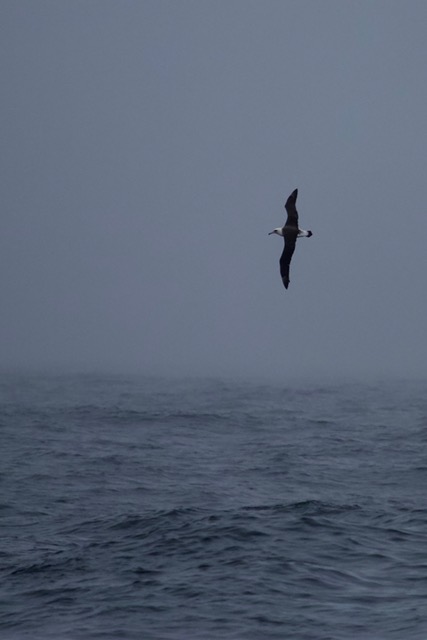

Transiting to the Bering Sea
This has been an unusual expedition so far. Our first week aboard has been simply transiting from Seward to our first station in the Bering Sea. Weather has been consistently drizzly and overcast. We had some big rolling waves, but the Sikuliaq handles them really well and everybody has had a chance to get their sea legs. It usually takes me a day or so to adjust to the motion of a ship. Seasickness manifests as dizziness and exhaustion for about 24 hours, and then I’m usually good to go. With the slow calm trip, I was able to skip the adjustment and feel comfortable right away. It’s a relief to not have to power through that experience this time.
This morning we pulled in to Dutch Harbor, Alaska to take on a container for the ship. Along with Kodiak, Dutch Harbor serves as the primary processing point for the Bering Sea fishery. If you’ve seen the show “The Deadliest Catch”, you know about Dutch Harbor and the crab industry here. Fishing is the major industry for the region, with U.S. landings of crab around $200M/year, but it’s dwarfed by the pollock fishery (think: fish sticks), which accounts for more than $700M/year. Understanding the ecosystem here, and therefore its economic impact, is a major reason we are out on this research cruise.
While the crew managed to onload the container, the scientists had a few hours to wander around ashore. Most of us took the opportunity to pick up some last-minute supplies at Alaska Ship Supply, the local store that has everything. In addition, I took a long walk to the native community village, just to stretch my legs, and to try to take some pictures of eagles. I tend to think of bald eagles as majestic symbols of our mighty nation. Here, they are just a nuisance. There are so many and they hang out in the dumpsters. To be fair, the dumpsters here are full of scraps from the fish processing plants. Either way, I still find them to be beautiful and impressive creatures.
Tonight we head north, making a direct 50+ hour steam to our first station. I’m ready for the sciencing to begin!
6/3/18
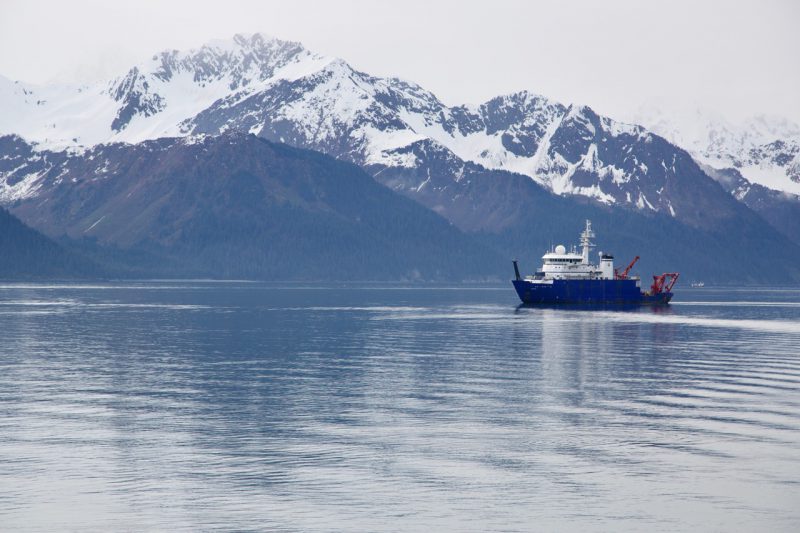
RV Sikuliaq
Getting to Seward
First things first, I have to get there. “The journey is the destination” takes on new meaning when it takes more than thirty hours of travel to get from home in Maine to the ship in Alaska. Even getting there can be an adventure. I was determined to make the most of it. By the time my plane landed in Anchorage, I had gotten through a few sci-fi novels, a movie, and of course some scientific writing. But Seward, where the ship was located, was still a five-hour train away. Those were the best five hours of travel I have ever experienced and have retroactively added the Alaska Railroad to my bucket list. Mountains and rivers and the sea were on every side as we wound our way south. I thought I would get stunning vista fatigue, but it seemed that every corner was a new incredible sight. We saw bald eagles, moose, wild Dall sheep, trumpet swans, a black bear or two, and more incredible snow-capped mountains than even have names. I spent most of my time hanging out the window, snapping photos, and gawking at the incredible sights. Five hours later, rolling slowly into Seward, I felt refreshed and ready to go and excited to be in Alaska.
I had originally planned to spend the afternoon in Seward hiking up the side of Exit Glacier, which is just outside of town. But there was a last-minute change to the departure schedule, meaning that we had one less day to get unloaded, set up and tied down before we disembarked. So, from the train depot I went directly to the ship, introduced myself to the chief scientist, and started unloading pallets. We spent the next 24 hours unpacking and setting up our shipboard laboratory, making sure we had all the supplies we needed before leaving shore. Nothing, absolutely nothing, is allowed to be loose. Once at sea, everything moves and slides and generally tries to fall over. I use a combination of bungees, ratchet straps, and a few go-to rope (I now prefer paracord actually) knots to lash everything down. In the back of my mind is the knowledge that if I’m missing something or a key piece of equipment breaks, there is nowhere to get a replacement. I’ve spent months preparing, checking and re-checking my packing list. This is my last chance to pick up any last-minute supplies. Thankfully, all seems to be where it should be. I can’t shake the feeling that I’ve forgotten something, but that probably says more about me than my packing job.
One of the interesting features of Resurrection Bay, where Seward is located, is that it is a fjord. The mountains continue to drop off even though we can’t see it below the water line. Within a few hundred feet of shore, the water depth is over 250 meters. Whales come all the way up the bay, feeding really close to shore and the ship’s dock. Standing on the deck or walking on the edge of town, the sound of blows and the gulls that surround them are ever-present. I’m in awe of the beauty and grandeur of this place. I hope to make it back some day to explore more, but for now I’m satisfied that I got a great adventure before I even begin.







All Rights Reserved © 2025 • Web issue?
Non-Discrimination Notice • Privacy Policy & GDPR